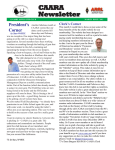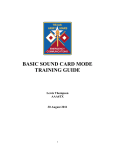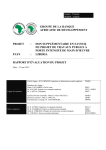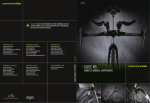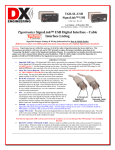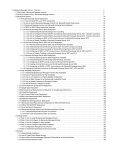Download August 2012 - Cape Ann Amateur Radio Association
Transcript
CAARA Newsletter AN ARRL AFFILIATED CLUB AN ARRL AFFILIATED CLUB President’s Corner by Stan-W4HIX July is a nice month to relax after the intensity of Field Day. With some of the major public service events cancelled this year in Gloucester, it has been pretty quiet. One thing I’ve noticed is though we had a good recovery from Field Day, there were a few things left undone—like getting the Butternut antenna back up and operational. We also need to check the big tents and assess the damage. Actually, not a lot of things to do, but if we work on them through the year, we’ll be better prepared. Gloucester has a new fire chief, and after he gets settled in a bit, I will be contacting him to tell him about CAARA and offer our services for the EOC and the normal public service activities. Talking about the EOC, we still have an antenna to get up for the MEMA VHF communications system. While we’re on the roof at Fuller School, we see if we can find a home for our 440 MHz repeater. We have a few maintenance items we should get finished up while the weather is not too hot, and not too cold. We should get some paint on the back of the building to get ahead on that task, so we’re not overwhelmed next year. We should get the chimney lined (still working on the price) and the emergency lights mounted. Boxboro is coming up at the end of August. This is always a good time—major vendors, a decent program and an opportunity to sell some gear— something we need to get done. Clearing out the old gear is especially important because we have a second floor to renovate. I want to thank everyone who has helped out, and if you haven’t had an opportunity recently—please lend a hand. AUGUST ISSUE- 2012 JUNE ISSUE- 2009 See you around the clubhouse. 73 de Stan, W4HIX Clerk’s Corner The CAARA Board of Directors would like to announce that per the club’s constitution the Annual Meeting will be held on Wednesday, September 12th at 7:30 PM at the clubhouse on 6 Stanwood Street in Gloucester. With that comes a new set of monthly member’s meetings and we are now looking for the membership to help with finding topics to cover. As well as giving presentations, or finding people to give them. They don‘t even have to be directly ham radio related.If you have an idea or would like to host a meeting please e-mail me at [email protected] Don‘t forget that the ARRL New England Convention in Boxboro is coming up the last weekend in August which is Saturday the 24th and Sunday the 25th. For contests the ARRL is holding the UHF contest on Saturday, August 4th and Sunday, August 5th. The ARRL VHF QSO party will be held on the weekend of September 8-10. For a couple of quick facts amateur radio licesnes were first given out back in 1912 and the Amateur Radio Relay League was founded by Hiram Percy M all CAARA members should update their membership information and we have made it very easy to do so. Just go to the “Members Only” section of the club’s website at www.caara.net and you‘ll see the members information update link. The club had another Field Day media hit in July with a picture of CAARA President Stan Stone W4HIX and Gloucester Deputy Fire Chief and Gloucester CERT liasion Miles Schlichtie standing next to the CAARA Emcomm trailer in the Beacon paper. Here‘s another CAARA fact. Did you know that according to the Visitors log at the clubhouse over 1300 club members and visitors were in the clubhouse at different times in a year and (continued on page 3) CAARA Newsletter Cape Ann Amateur Radio Association 6 Stanwood Street Gloucester, MA 01930 CAARA Newsletter is a monthly publication of the Cape Ann Amateur Radio Association (CAARA). It is the policy of the editor to publish all material submitted by the membership provided such material is in good taste, relevant to amateur radio and of interest to CAARA members, and space is available. Material is accepted on a first come, first serve basis. Articles and other materials may be submitted by internet to Jon at [email protected]. If possible, material should be in Word format.Material may also be submitted as hard copy to Jon-K1TP or any Club Officer. All material published in the CAARA Newsletter may be reproduced for noncommericial use provided such use credits both the CAARA and the author of the article. Copyrighted material will not be accepted without accompanying written permission to publish. The opinions expressed in the CAARA Newsletter are solely those of the editor or other contributors and do not necessarily reflect the opions of either the Board of Directors or membership of CAARA. Jon Cunningham- K1TP Editor Dean Burgess- KB1PGH Cub Reporter Board of Directors- 2011-12 Welcome to CAARA: CAARA, an ARRL affiliated club, operates the 2 meter W1GLO repeater on 145.130 MHz with antennas located on the Cingular tower in the Blackburn Industrial Complex in Gloucester Massachusetts. It has an average effective radius of 60 miles, and serves Eastern Massachusetts, Cape Cod, Rhode Island, Southern New Hampshire, and maritime mobile stations. CAARA also operates the W1GLO repeater on 224.900. The former W1RK 443.700 repeater with antennas located in Magnolia is now located at the CAARA clubhouse and has a very limited range. The Association is one of the few amateur radio clubs that has its own clubhouse. Located at 6 Stanwood Street in Gloucester, it includes a permanent HF station with rotating beam and vertical antenna along with a 2 meter packet station and 2 meter voice and 220 MHz transceivers. Amateur radio exams are held on the second Sunday of each month at 10:00AM at the CAARA clubhouse. Anyone who is considering a new license or an upgrade, is welcome to test with us. There is no pre-registration necessary. Contact the head of our VE team Bob Quinn if you have any questions about monthly testing. President: Stan Stone W4HIX Vice Pres: Dick Mac Pherson WB1W Treasurer: Hank McCarl W4RIG Clerk: Dean Burgess KB1PGH Monthly member meetings are held on the first wednesday of each month at 7:30 PM except for July and August. Directors: Paul Anderson, KA1GIJ Jon Cunningham, K1TP Charles Downey, N1OCT Joseph Perry, KB1VQF Dick Ober, K1VRA Don Swenson, N1UVV Ruth Hodson- WW1N Each Sunday evening at 9:00pm, the club operates a 2 meter net on 145.130. This is an open and informal net which disseminates club news and prepares operators for emergency communications work. All are invited to check into the net as club membership is not a requirement. CLERK’S CORNER (continued from page 1) a half ! For those who may not know the CAARA Clubhouse was once a fire station back in the early 1900‘s. Then it was a community center back in the 50‘s and 60‘s.Then it held a pigeon racing club in the 70‘s. CAARA was formed in 1977 and moved in upstairs in the 80‘s. Then CAARA took over the whole building. By the way, if you enjoy the CAARA newsletter every month, we are always looking for members to write articles or send in pictures of the ham shacks for newsletter publication. That‘s it for August. FCC Denies Petition Seeking to Designate Nationwide Emergency Calling Frequency (ARRL) Saying that it believes that the Amateur Service “allows flexibility to provide emergency communications in a way that takes into account channel availability and other local conditions,” the FCC denied a Petition for Rulemaking to create a nationwide emergency calling frequency. The Petition — filed by Bryan Boyle, WB0YLE, of Morrisville, Pennsylvania, and Jim Dixon, WB6NIL, of Alhambra, California — called upon the FCC to designate 146.550 MHz as a “non-exclusive nationwide Amateur Radio Service emergency communications channel using FM wideband modulation.” Doyle and Dixon noted in their Petition that other services, such as the Citizens Band Radio Service, the Aviation Service and the Maritime Service have specific channels set aside for emergency communications. They claimed that use of these How many uses can you think for a 0 ohm resistor? channels “to good effect by those in distress [and that this] is a testament to the need for individual services NEW BROADCAST CENTER PROPOSED FOR to have a readily accessible and publicized” ONE WORLD TRADE CENTER emergency communications channel. In denying the And finally this week, the new spire built to replace Petition, the FCC said in part that Boyle and Dixon the fallen twin towers of the World Trade Center in “had not shown an existing problem that would be New York City will also become an antenna site. addressed by a rule change designating a nationwide The Durst Organization that controls New York City's One World Trade Center in a partnership with The Port Amateur Service emergency calling frequency.” The FCC told Boyle and Dixon that the rules of the Authority of New York and New Jersey plans to add Amateur Radio Service allow “an amateur station to an installation for FM radio and television transmission antennas in the building's 408-foot spire. One that transmit one-way messages necessary to providing will ultimately bring the new building's height to 1,776 emergency communications,” maintaining that these feet and make it the tallest building in North America. messages may “be transmitted on any frequency authorized [by] the control operator of the amateur The Empire State Building, 1,250 feet tall with its 204 stations transmitting the messages. Additionally, the rules require that, at all times and on all frequencies, foot antenna tower is currently the home to 19 FM each control operator must give priority to stations stations and most of the city's digital television transproviding emergency communications. Administration mitters. Many radio and television broadcasters miof these rules is accomplished primarily through grated to the Empire site after terrorist attacks of 911 voluntary frequency planning by, and cooperation caused the collapse of the World Trade Center's twin among, Amateur Radio operators.” towers in lower Manhattan. Pointing out that the its Wireless Telecommunications Bureau had previously considered establishing a Yet to be determined is whether any of the city's FM nationwide common calling or distress channel “in a broadcasters will leave their current primary sites at service where transmission of such communications is Empire State Building for the new location at One permitted but not required...and the channels are World Trade Center or if they will treat the new (continued on page 19) building spire primarily as a backup site. Atlantic Hurricane Season 2012 On the IARU Region 1 site G0DUB reports on the Atlantic Hurricane Season There have been four ‘named storms’ in the Atlantic already this year and though none have made the news it is time for the reminder that Amateur Radio continues to play a part in gathering and distributing information for the weather and emergency services each year. Radio Amateurs in Region 1 are reminded that the following frequencies may be in use by nets in North and Central America to track and deal with the consequences of these severe weather events. It is possible for Region 1 amateurs to cause unintentional QRM to these nets so please listen carefully if operating near these frequencies: 14.300 MHz is used by the Maritime Mobile Service Net daily and as well as handling traffic from Maritime Mobile Stations, also gathers weather reports from maritime stations to assist forecasters. 14.325 MHz is used by the Hurricane Watch Net and the net is established whenever it appears that a storm may affect the US mainland. The net gathers weather information and links to the American National Hurricane Centre. 14.265 MHz is used by the Salvation Army Team Emergency Radio Network ( SATERN ) provides Health and Welfare traffic links for those in affected areas as well as supporting the Salvation Army Disaster relief response should a hurricane strike. Frequencies used in Cuba: 7.045, 7.080, 7.110 MHz, 3.740 MHz Frequency used in the Carribean: 7.162MHz by the CEWN Frequencies used in Central America; Red Centro Americana : 7.090 and 3.750MHz Guatemala: 7.075 MHz Nicaragua: 7.098 MHz Mexico (FMRE): 3.690 and 7.060 MHz Cuba and Mexico co-operate with long distance relays on 40m when propagation makes this possible. Local emergency communications groups may also activate if a hurricane approaches their area and those frequencies would be announced at the time. CLUB NEWS Hello to all CAARA members, The Essex Board of Health has requested our assistance to provide comunications for their Youth Triathalon coming up on Saturday August 11th.The triathalon takes place near Centennial Grove in Essex. It starts at 9:30 AM and always ends before 1 PM. We have worked this event the past two years, We park behind the Essex police station and take a shuttle in. We are looking for at least 6 hams to work this event. If you want to help us out please e-mail me back at [email protected] As per the clubs constitution the Cape Ann Amateur Radio Association will hold its Annual meeting on Wednesday September 12th at 7:30 PM at the clubhouse on 6 Stanwood Street in Gloucester Mass. The Annual meeting will consist of the yearly review of the clubs finances by club Treasurer Hank McCarl W4RIG.Then CAARA President Stan Stone W4HIX will present the State of the club address,along with a set of goals for the upcoming year.Then the Board will open the floor for any discussions or ideas from the membership.The final order of business will be the election of,or reelection of Officers or Directors postions.All Caara members are encouraged to attend this meeting as your input and voting is vital to the clubs management.If you are planning on attending this meeting I would highly recommend reading through the clubs Constsitution which can be found on the membership page on the clubs website at www.caara.net .If you have any questions about the Annual meeting please e-mail me at [email protected] Q: Why do ships and aircraft use “mayday” as their call for help? A: This comes from the French word m’aidezmeaning ‘help me’ — and is pronounced, approximately, ‘mayday.’ A Garden Plot by Curtis Wright- AA3JE When I was young, my parents would rent me out to the old ladies in the neighborhood who needed a “boy” to help them out. What they really wanted was a 45 year old professional gardener named “Cedric” who appreciated older ladies, but what they got was me. I never go the hang of it, and was especially wary of “land clearance” projects extending the petunia patch. So I never learned how to do it very well. Now, 45 years later, I found myself with a 40 by 50 foot area covered in the worst, thorny, prickly, rocky, messy tangle imaginable. It started at a rubble wall, now a collapsed dirt bank, and sloped away down to the road. At least I thought it did. It was all thick, twisted, and very nasty. And I had to clear it. After trying a few different techniques, I found that using a set of four-foot limb loppers and clipping the brush level with the ground was as good as anything. The usual method, favored by my neighbors, was to hire “Barry”, who for $6000 would strip it clean in an afternoon, but the essence of “hobby” is “cheap” and so I clipped and hauled brush out of there till I had clear soil. Well, sort of soil. Not exactly soil, more like soil fragments between the rocks. Turns out that the reason the previous owners had left all that gosh-awful stuff there was that there was about 1-2 inches of soil and muck over a field of boulders, ledge and granite, such that nothing but bracken could grow. Then I had the great idea. Normally I just lie down till these ideas go away, but this one had some legs. I could border the garden with the big rocks I had removed from the back yard, and I could use bagged topsoil for the garden bed, after adding enough sand to make it a little less gooey. I tested the existing soil (always wise in Rockport where early industry had been a little careless with the cyanide) and all came back clean. So I set about laying out my little garden plot. This is a good time to mention that I was not a good student in elementary school. I got better in college, but I never learned to type, do simple math, figure the volume of a pyramid, or any of the other things that most of today’s kids pick up by 6th grade. So I laid out my garden with blithe disregard as to the volume of soil needed to fill even the smallest garden. I positioned my rocks, built a wall, went to the hardware store, bought 5 bags of topsoil, and returned. I dumped the bags, and to my horror, found that 5 bags produced a thin film of dirt, perhaps 1/4 of an inch in thickness. I called the hardware store. “Do you offer a volume discount on soil?” “Are you a preferred customer?” “I’m in there six times a day, does that count?” ”We can offer you 5%” I spent a few hours brushing up on the “volume of solids” in my son’s old math book, and figured that my garden would cost about $5,000 if I bought the soil in bags. I next called the Big Nursery in the next town. “Do you have topsoil for sale?” “Oh yes sir, finest loam, how much do you need?” “How much is it?” “ $30 per cubic yard you pick it up.” “Do you deliver?” “Not soil, sir, the profit margin is too slim.” This was better, but still in the $1750 range. I needed lower prices. I knew where I could get some soil free, but it came with a catch. I had to shovel it. For those with a burning need to know, 30 cubic yards of soil consists of 810 cubic feet, or 1,620 trash cans full of dirt. Each trash can consists of 18-19 shovels full, making it roughly 30,000 shovels full of soil. I know, I counted. I shoveled dirt before work, I shoveled dirt at noon, I shoveled dirt on weekends, and after 2 full months of this I had a 50 by 10 foot garden bed. (I was also in excellent shape, but had developed this nagging back problem and a curious postural tilt). It leveled out nicely, was thick, black and rich, and then it rained. By this time I had found that an Internet site called Abe Books had cornered the market on old library and text books, and had ordered a number of books on gardening and agriculture. I found, to my chagrin, that there was a significant gap in such literature. There were lots of recent books of the “Gardening is fun” and “My First Garden”, then you jumped to “Soil, a Comprehensive Textbook for Higher Level Agronomic Studies. The first class of books were understandable, “Soil is the place where plants grow”, but thin on details. The second class of books all started with “Chapter 1, Taxonomy and Podophilic Derivation of Soil Classes” and tended to be a bit opaque. I finally found out that if you went back to the 1950s, there were a few books that a mortal might understand. I perused the texts, and found the relevant passage, “Oxidation changes the nature of highly organic soils, releasing plant nutrients. this transformation changes the nature of the organic material so significantly that its name is changed to muck”. Muck. Really gooey, clinging muck. I was delighted to find out that It was considered highly fertile, well suited to vegetables, and that while it would all oxidize away in a century or so, the stuff would last much longer than I would. There was a little problem, however. Muck clings. To everything. To feet, to boots, to clothes, and it is amazingly potent at leaving little black balls of gunk everywhere. this would have been OK if I had not married a Swedish wife. Swedes are neat. Sweden is a very clean, neat country where homeowners sweep the street in front of their house If it gets dirty. Swedish women hate dirt, are amazingly good at spotting it, and always assume that any brown material on the carpet is fecal in origin. “WHAT IS THAT? DID YOU BRING THAT IN ON YOUR FEET? WHAT A SCANDAL. I CAN’T LIVE LIKE THIS ANYMORE!” I would look around, the dog would look around, the other dog would look around. We’d check our paws, we saw nothing. My wife, trembling in the grip of strong emotion would point out the 1/4 inch ball of goo sitting on the rug, and we would hang our heads in shame. It now became obvious why the women in the “sod huts” of the American Midwest all looked so sour. It was the dirt. I tried everything. The system that seemed to work best was keeping the boots in the garden, switching to “transitional slippers”, taking those off in the garage, and changing clothes downstairs. by the time we worked the system out it seemed to me that I was in training for a job in a level 5 biohazard facility or a nuclear power plant. But it was worth it. I had a nice, new garden plot filled with nice new productive soil. And I had not the slightest idea what to do next. HAM STUFF: NEW FREQUENCY CHART AVAILABLE FROM US GOVERNMENT BOOKSTORE If you have ever had the yearning to own one of those nifty United States radio spectrum posters to hang on your wall, now is your chance to get one. Properly titled the United States Frequency Allocations: The Radio Spectrum Chart, the very latest edition is now available from U.S. Government Printing Office Book Store at a cost of $12. To order yours, take your web browser to tinyurl.com/bigfrequency- map and follow the directions you will find there. HAM RADIO IN SPACE: FITSAT-1 - A VISUAL MORSE CODE BIRD Call this one visual Morse code from space. This with word that the FITSAT-1 ham radio cubesat will carry an optical communications experiment that aims to write in C-W across the night sky using super high intensity LED’s as a lighting source. FITSAT-1 will be carried to the International Space Station on July 21st from where it will be deployed sometime in September. For more information see www.uk.amsat.org/2037. CAARA provides Communications for the July 4th Horribles Parade !! Several members of the Cape Ann Amateur Radio Association provided public service communications for the Gloucester Fishtown Horribles parade on tuesday July 3rd. A radio net was established on the clubs 2 meter repeater frequency of 145.130 MHZ with no Pl tone at 5:30 PM. The members of CAARA were spread out along the parade route and reported back to net control on traffic and safety issues, as well as any large gaps between parts of the parade. Dean Burgess- KB1PGH was net control in the lead Gloucester Police cruiser and relayed any necessary information to the Gloucester Police Department. CAARA member Bob SpanksWA1UCG was in the trail vehicle and relayed vital inforamtion on other traffice issues,the ongoing pace of the parade and where the end of the parade was street by street. There were 8 members of CAARA who were on station for 3 hours each so that adds up to a total of 24 volunteer hours to the city. The Horribles Parade Committe would like to thank the following other members of CAARA for their service.Especially for answering the call to help out with the parade on such short notice! Curtis Wright AA3JE Ron Beckly N1RJB Ruth Hodsdon WW1N Sue Downey N1XQW Hank McCarl W4RIG Tony Marks N1JEI WE MADE THE LOCAL GLOUCESTER DAILY TIMES NEWSPAPER FOR FIELD DAY Antenna Restrictions on Mt. Evans? I activated Mt. Evans for Summits on the Air (SOTA) on July 15th. I took the route from Summit Lake to the top early in the morning since thunderstorms were in the forecast for the afternoon. I had the peak to myself for almost half an hour which was unexpected, considering that there is a road all the way to the top. I setup my vertical Buddipole for 20m and started my activation – so far nothing out of the ordinary besides the bad band conditions due to the recent CME. I was talking to ACØA in Kansas when I spotted a National Forest Ranger running up the path from the parking lot. I could not understand what he was saying since I was distracted by my ongoing QSO and the lack of oxygen combined with his running up the mountain made his signal about a 22, with highly distorted audio. He arrived at the summit breathless and stood next to me, courteous enough to let me finish my QSO (or just to catch his breath?). He then introduced himself and informed me that I have to take down the antenna immediately. My first thoughts were that the antenna was considered some sort of a safety hazard for other visitors but NO. The reason is, he informed me, that you cannot build a structure on Nation Forest land without a permit. Sounds like a sensible rule to me…. who wants to see cabins etc. erected on public land everywhere. I argued that my antenna can hardly be considered a structure and my short survey among the few visitors on the summit (~10 people) came to the same conclusion – nobody considered my antenna a structure but he insisted. Furthermore he instructed me to drive to the Clear Creek Ranger District HQ in Idaho Springs to get a permit. Needless to say that I was not planning to make a ~60 mile round-trip to get a permit for my activities. I already had enough contacts for my Mt. Evans SOTA activation and the fact that I had planned another activation for later in the day I did not want to waste my time arguing and started to pack up. Luckily I had my tape-measure YAGI with me for my next activation and I was hoping it would pass the NOT BEING A STRUCTURE test by the National Forest (to make sure I did not ask). I tried to follow up with the person in charge for the Clear Creek Ranger District… she is on vacation. Sure glad I did not drive all the way to Idaho Springs. GOOGLing, I found Forest Rules You Need to Know, published by the Secretary of Agriculture. On page two, under the chapter OTHER PROHIBITED FACTS it indeed prohibits “Constructing, placing, or maintaining any kind of communication equipment without a special use authorization“. Again, that makes sense to me to avoid that every Tom, Dick and Harry sets up his own repeater on public land… it does however not make sense to me for a temporary, mobile/portable antenna as I was using. It would certainly put a damper on SOTA activations and the upcoming 14er event. I am almost certain that on Field Day a lot of antennas go up on NF land. I would be interested in your experience and/or opinion and I am planning to follow up with the Clear Creek Ranger District. Maybe I was just dealing with an overly eager Ranger? Stay tuned… Matt/KØMOS Not going out with our Thacher Island crew in August, but wondering what the view is like from the island! Well have re-installed the web cam on the island for viewing. Attached is some notes on how to connect. Camera is mounted inside one of the houses looking out in a North direction towards the National Wildlife Section of the Island. For more info on the island check out the web site, http://www.thacherisland.org . Enjoy the view. Dick MacPherson [email protected] Here‘s Ken- KA1OH, Hank- W4RIG, Jake- K1LDL, and Paul- W1LPM at the N1MM training session back in June. RADIO LAW: ARRL SAYS NEW EXECUTIVE ORDER POSES NO THREAT TO HAM RADIO According to the ARRL, an executive order dealing with telecommunications poses no threat to the amateur radio service. On Friday, July 6th the White House released an Executive Order signed by President Obama that addresses the National Security and Emergency Preparedness communications functions of the federal government. Contrary to some concerns raised in a few amateur radio circles, the order does not appear to contain any threat to the Amateur service or its ability to continue support communications during times of emergency or disaster. It also poses no threat to hams for continued access to their spectrum. Dan Henderson, N1ND, is the League’s Regulatory Information Manager. He explained that the purpose of the new entity, which would be created within the Executive Branch by this Order, appears to be to plan for future National Security and Emergency Preparedness communications and to insure survivability, hardness and interoperability. It will also develop a long-term strategic plan for National Security and Emergency Preparedness communications. Henderson noted that based on the Amateur service’s ongoing, positive working relationship with officials at the Department of Homeland Security’s Office of Emergency Communications, it is hard to envision that any new management plan would not include Amateur Radio. N1ND says that nothing in this Order directly affects amateur radio’s daily operations. Ruth-WW1N learns how to add an optional cw filter to her FT-817 with Larry’s help at the clubhouse. Remove the cover, insert the CW filter in the correct slot, and then go to the meun system to activate it. IPSWICH EMERGENCY MANAGEMENT CONDUCTS HAM RADIO DRILL Ipswich Emergency Trailer Visitors that came to the site learned about ham radios, CERT teams, and disaster preparedness. I wonder if there tents blew down like our did on Field Day? Looks like they did a wonderful job operating as well as promoting amateur radio. ABOVE; Bill Poulin- WZ1L chrecking into the I.O.O. K. 20 meter SSB net on Sunday morning at the clubhouse.The I.O.O.K is short for the, International Order Of Crazies”, a brotherhood of amateur radio operators all across the world. Bill checks into the net every Sunday morning that he is at the clubhouse. For more inforamtion on this brotherhood, you can go to their website at www.iook.org . You can also see some more pictures that Bill took of CAARA‘s past Field Day along with a nice write up for the I.O.O.K. crew. BELOW: K1TP checking out the Hammerlund HQ 129 X transciever and Hallicrafter’s Super Defiant receiver at the clubhouse. If anyone is interested in purchasing either of these two radios as part of the club fundraiser please contact CAARA President Stan Stone- W4HIX at [email protected] . Remembering Silent Keys After a ten year period of being away from ham radio, I came back to find many of the DX hams I have had the pleasure to meet were now silent keys. This started me thinking, of hams I have met at CAARA. In coming months, I’ll try to bring back memories of hams who have moved on. A few weeks after I received my license in 1977, Warren, WA1YLX the president of they start again on 435.365.000 MHz FM. After about six minutes the pattern changed and there where only signals on 435.365 MHz FM. When you listen close there is a difference between the pattern from the first recording and the second. Something that can’t be seen after the recording, is the fact that the signals of the first pattern have a higher bandwidth, and therefore likely to have a higher baud rate. Data received from RS-40 http://www.pe0sat.vgnet.nl/2012/i-received-datefrom-rs-40/ First signals from RS-40 http://www.pe0sat.vgnet.nl/2012/first-signals-fromrs-40/ CAARA came into my shack and invited me to join the club. Yubileiny-2 (RS-40) http://www.pe0sat.vgnet.nl/2012/yubileiny-2/ During the time I knew him, I never could tell when he was just pulling my leg. Larry, W1EGJ was well into his 80s and as energetic as a man in his 40s. Larry was very active in the club. During FD, He would load his truck with ham gear and take off The website of Andy Thomas G0SFJ has information on the earlier Yubileiny-1 (RS-30) satellite at https://sites.google.com/site/andythomasorg/ amateur-satellites/ rs-30-yubileiny History This Week Larry gave me his HT. When I went to return it he A look back at events that made history this week compiled by the Summerland Amateur Radio Club of Lismore, NSW said,”Keep it” Until Next time, Joe, WB1CHJ Monday, 30 July, 2012 New Russian Satellite RS-40 1181 Supernova observed by Chinese & Japanese astronomers 1375 First roller skating rink opens (London) 1774 Priestly discovers oxygen 1919 First air flight over a major body of water in Australia (Harry Butler) 1945 Atom Bomb dropped on Hiroshima (Aug 6th in Japan) 1956 First motorcycle rode over 200 mph (Wilhelm Herz-210 mph/338 kph) 1959 Explorer 6 transmits first TV photo of Earth from space 1977 Radio Shack issues a press release introducing the TRS-80 computer. 25 existed, within weeks thousands were ordered to the site. When I went to Florida, MiR also known as Yubileiny-2 and RS-40 was built by students and research staff of the Siberian State Aerospace University and launched on July 28 It is understood signals from RS-40 on 435.365 MHz were first reported by Maik Hermenau on the AMSATDL mailing list. Jan PE0SAT reports on his website: The first signals, switch between the two downlink frequencies, when the signals stop on 435.265 MHz FM MORE FIELD DAY PICTURES Pic#1 Jake “Honeybadger”-K1LDL showing a youngster how to assemble the 6 meter rotor Pic #2 Bob Edwards- AB1LT working 40 meters in the CW tent during field day CAARA Portable Digital Station Inventory Radio Module (Components Mounted in Tactical Radio Carrier) ICOM IC-706MkIIG HM-103 Microphone IC-706 DC Power Cable THE STATION THAT IS GOING OUT TO THE THACHER ISLAND ACTIVATION SPOINSORED BY CAARA LDG IT-100 Autotuner Cable - Radio to Tuner RF Jumper Cable - Radio to Tuner Control Power Supply Module (Components Mounted in Tactical Radio Carrier) Jetstream JTPS30M 30A DC Power Supply West Mountain RIGrunner 4004 USB Anderson Powerpole DC Power Distribution AC Power Cord (IEC) IBM T43 Laptop Computer Laptop AC/DC Power Supply USB Cable (Signalink to Computer) Signalink USB Digital Interface SLMOD6PM - Jumper programming module SLCAB6PM – Cable for 6-Pin mini DIN Data / Accessory Port Connector Generic USB to CAT I/F Cable for IC-706 (Prolific PL2303 based USB-Serial converter) AC Extension Cord—three outlet Miscellaneous RF Connectors Briefcase Style Carrying Case Documentation ICOM IC-7086MkIIG User Manual LDG IT-100 Operations Manual Tigertronics Signalink USB Installation & Operations Sound Card Program Setup Instructions QST Review of Signalink USB Nice job by Stan-W4HIX FCC Denies Petition (from page 3) shared by all users,” the FCC said that it had concluded that “it was not necessary to designate a Family Service Radio (FRS) channel for establishing emergency communications because emergency communications have a priority on all FRS channels and the record did not demonstrate that FRS users were having any difficulty establishing communications.” The FCC did note, however, that unlike channels in the Citizens Band Radio Service and the Maritime Service, channels in the FRS are not routinely monitored by emergency first-responders: “Like the FRS, the Amateur Service differs from the services in which our rules designate a nationwide emergency calling channel in that it is not routinely monitored by safety entities such as the police or the Coast Guard. Additionally, those services do not require an individual to have an operator license or otherwise demonstrate the ability to operate the station by performing such functions as selecting transmitting channels to avoid interference. Therefore, we believe the administration of these services primarily through operational rules that specify the use of a channel and transmitter technical standards is reasonable.” The FCC observed that under the current rules of the Amateur Radio Service, operators can use “multiple channels on the same or different amateur band if needed for an event, or use multiple channels in the same band when multiple, but different events occur.” It also mentioned that the Boyle and Dixon’s proposal “that the channel be a ‘non-exclusive nationwide’ channel is, substantively, no different from current channel priorities because all Amateur Service channels are shared and may be used for providing emergency communications. If such a ‘non-exclusive nationwide’ channel is needed, nothing in our rules prevents the amateur community from voluntarily agreeing to designate a channel for this purpose. We conclude, therefore, that you have not shown an existing problem that would be addressed by a rule change designating a nationwide Amateur Service emergency calling frequency.” Heathkit Declares Bankruptcy, Closes for Good (Again): from The ARRL Letter on July 26, 2012 Heathkit Declares Bankruptcy, Closes for Good (Again): The July 19 edition of The Herald-Palladium — a newspaper serving the communities of Benton Harbor and St Joseph, Michigan — is reporting that Heathkit Education Company has declared bankruptcy and has officially closed its doors after defaulting on its lease. According to the paper, Heathkit employed more than 1800 people in its heyday after World War II. When it finally closed, its workforce totaled fewer than six people. This is the second time since 1992 that Heathkit Educational Services has shuttered its doors. In August 2011, Heathkit announced it was returning to the kit building business, and in September, that it would once again be manufacturing Amateur Radio kits. Read more here http://www.arrl.org/news/heathkit-declaresbankruptcy-closes-for-good-again. We need your help! The reorganization of the second floor will start in August with Jake-LDL and Jon-TP and other volunteers of any skill set and amateur radio experience. This is a great opportunity to help setup HF SSB, CW, and digital stations. There is something to be learned by everyone no matter how long you have been hamming! I believe we will be clearing stuff from one side of the room and setting up stations on tables that will be against the exterior walls. We want to have open space in the middle of the room and make the appearance of the stations to be neat, clean, and setup in good operating practice. If you have a few hours here and there, give Jake or Jon or Dick Ober a call on the repeater or during the Sunday two meter net.



















